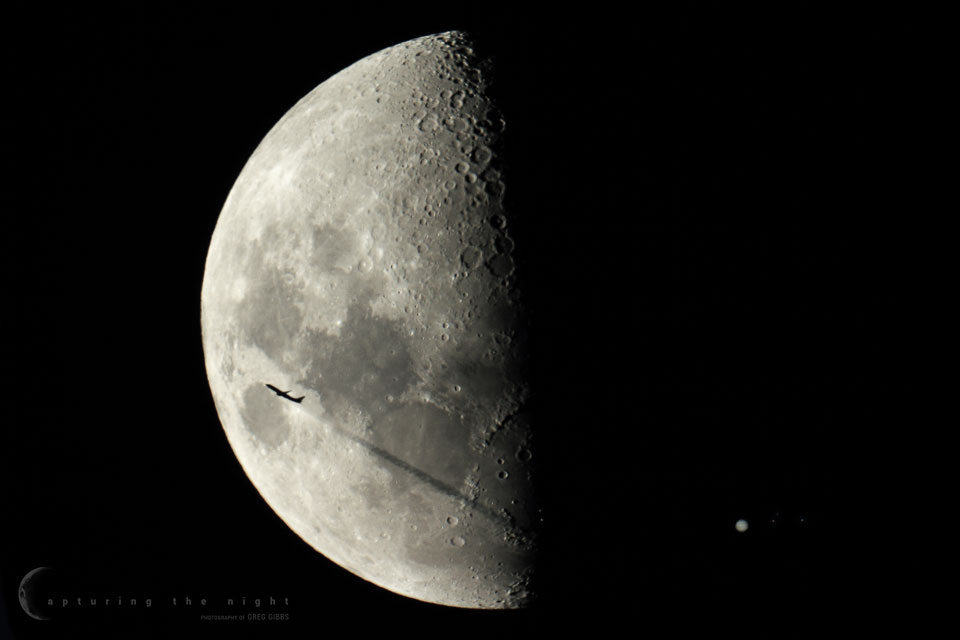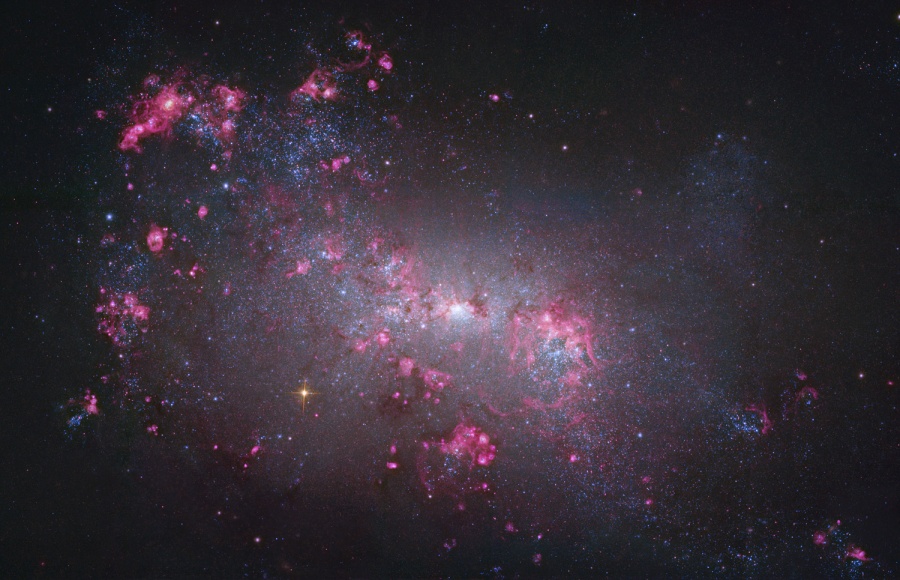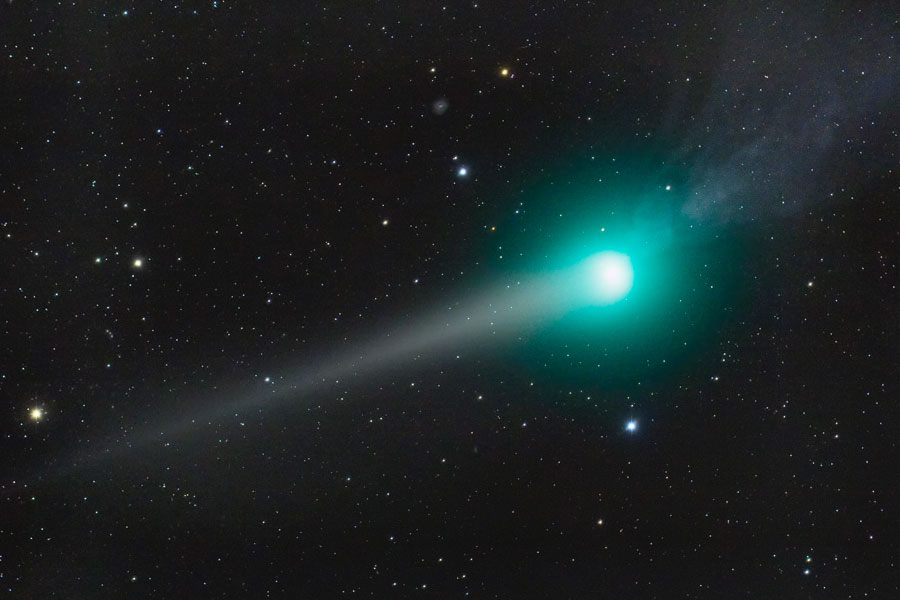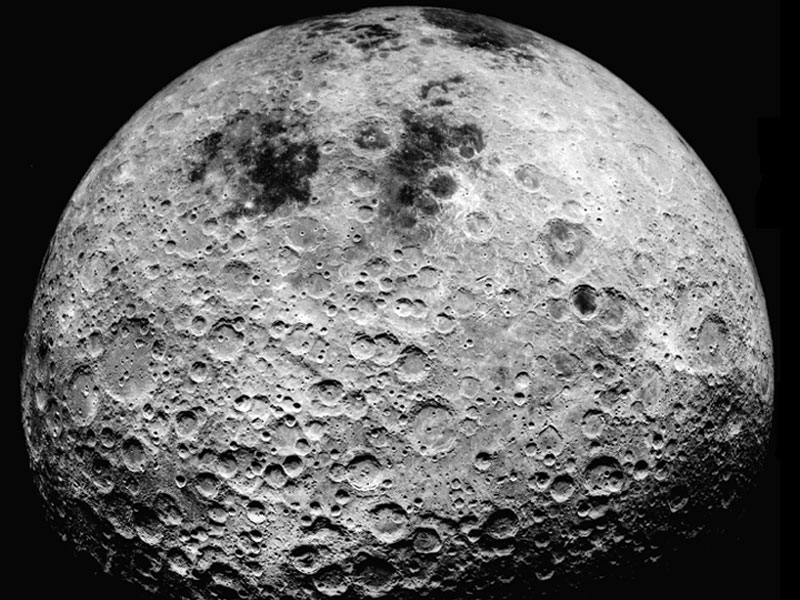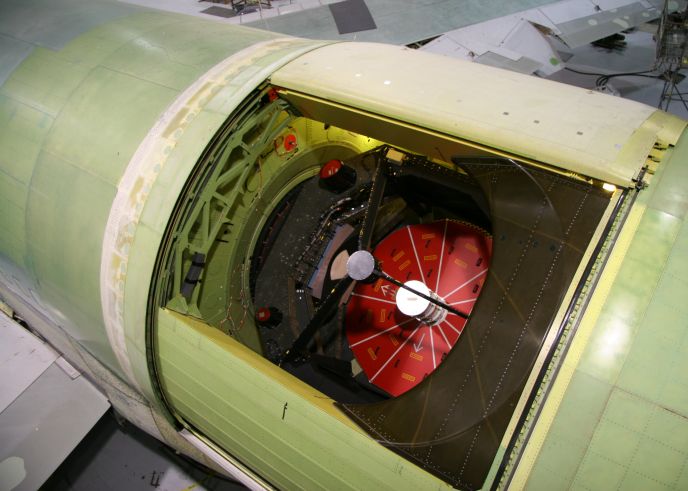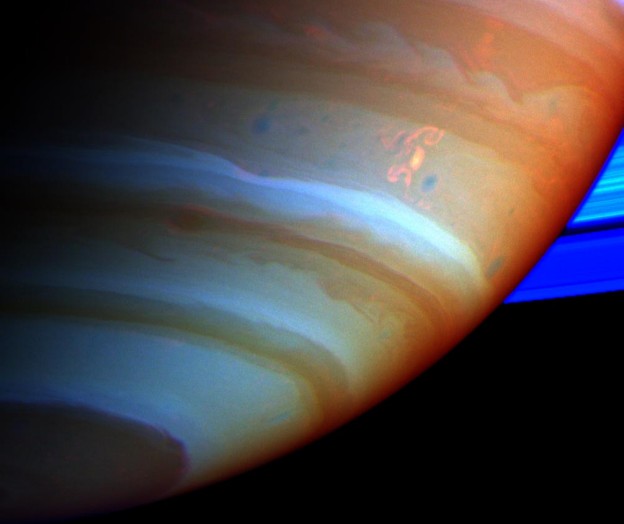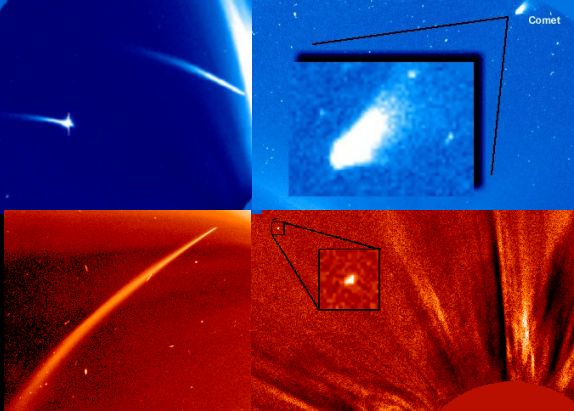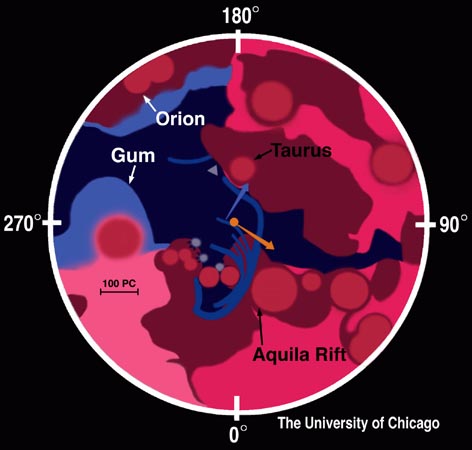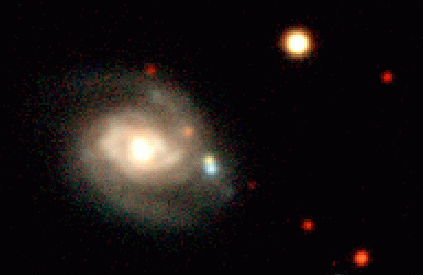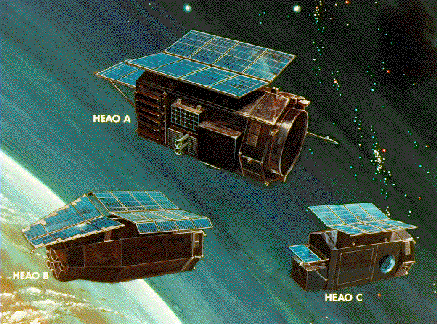| << Previous | Index | Next >> |
2015The Rosette Nebula is not the only cosmic cloud of gas and dust to evoke the imagery of flowers -- but it is the most famous. At the edge of a large molecular cloud in Monoceros, some 5,000 light years away, the petals of this rose are actually a stellar nursery whose lovely, symmetric shape is sculpted by the winds and radiation from its central cluster of hot young stars. The stars in the energetic cluster, cataloged as NGC 2244, are only a few million years old, while the central cavity in the Rosette Nebula, cataloged as NGC 2237, is about 50 light-years in diameter. The nebula can be seen firsthand with a small telescope toward the constellation of the Unicorn (Monoceros).
2014 The well known Pleiades star cluster is slowly destroying part of a passing cloud of gas and dust. The Pleiades is the brightest open cluster of stars on Earth's sky and can be seen from almost any northerly location with the unaided eye. The passing young dust cloud is thought to be part of Gould's belt, an unusual ring of young star formation surrounding the Sun in the local Milky Way Galaxy. Over the past 100,000 years, part of Gould's belt is by chance moving right through the older Pleiades and is causing a strong reaction between stars and dust. Pressure from the stars' light significantly repels the dust in the surrounding blue reflection nebula, with smaller dust particles being repelled more strongly. A short-term result is that parts of the dust cloud have become filamentary and stratified, as seen in the above deep-exposure image.
2013 Sometimes the Moon is a busy direction. Last week, for example, our very Moon passed in front of the planet Jupiter. While capturing this unusual spectacle from New South Wales, Australia, a quick-thinking astrophotographer realized that a nearby plane might itself pass in front of the Moon, and so quickly reset his camera to take a continuous series of short duration shots. As hoped, for a brief instant, that airplane, the Moon, and Jupiter were all visible in a single exposure, which is shown above. But the project was not complete -- a longer exposure was then taken to bring up three of the Jupiter's own moons: Io, Calisto, and Europa (from left to right). Unfortunately, this triple spectacle soon disappeared. Less than a second later, the plane flew away from the Moon. A few seconds after that, the Moon moved to cover all of Jupiter. A few minutes after that, Jupiter reappeared on the other side of the Moon, and even a few minutes after that the Moon moved completely away from Jupiter. Although hard to catch, planes cross in front of the Moon quite frequently, but the Moon won't eclipse Jupiter again for another three years.
2012 The first identified compact galaxy group, Stephan's Quintet is featured in this eye-catching image constructed with data drawn from the extensive Hubble Legacy Archive. About 300 million light-years away, only four of these five galaxies are actually locked in a cosmic dance of repeated close encounters. The odd man out is easy to spot, though. The interacting galaxies, NGC 7319, 7318A, 7318B, and 7317 have an overall yellowish cast. They also tend to have distorted loops and tails, grown under the influence of disruptive gravitational tides. But the predominantly bluish galaxy, NGC 7320, is closer, just 40 million light-years distant, and isn't part of the interacting group. Stephan's Quintet lies within the boundaries of the high flying constellation Pegasus. At the estimated distance of the quartet of interacting galaxies, this field of view spans about 500,000 light-years. However, moving just beyond this field, above and to the left, astronomers can identify another galaxy, NGC 7320C, that is also 300 million light-years distant. Of course, including it would bring the interacting quartet back up to quintet status.
2011 Grand spiral galaxies often seem to get all the glory. Their young, blue star clusters and pink star forming regions along sweeping spiral arms are guaranteed to attract attention. But small irregular galaxies form stars too, like NGC 4449, about 12 million light-years distant. Less than 20,000 light-years across, the small island universe is similar in size, and often compared to our Milky Way's satellite galaxy, the Large Magellanic Cloud (LMC). This remarkable Hubble Space Telescope close-up of the well-studied galaxy was reprocessed to highlight the telltale reddish glow of hydrogen gas. The glow traces NGC 4449's widespread star forming regions, some even larger than those in the LMC, with enormous interstellar arcs and bubbles blown by short-lived, massive stars. NGC 4449 is a member of a group of galaxies found in the constellation Canes Venatici. Interactions with the nearby galaxies are thought to have influenced star formation in NGC 4449.
2010 This beautiful cosmic portrait features NGC 891. The spiral galaxy spans about 100 thousand light-years and is seen almost exactly edge-on from our perspective. In fact, about 30 million light-years distant in the constellation Andromeda, NGC 891 looks a lot like our Milky Way. At first glance, it has a flat, thin, galactic disk and a central bulge cut along the middle by regions of dark obscuring dust. Also apparent in NGC 891's edge-on presentation are filaments of dust that extend hundreds of light-years above and below the center line. The dust has likely been blown out of the disk by supernova explosions or intense star formation activity. Faint neighboring galaxies can also been seen near this galaxy's disk.
2009 Go outside tonight and see Comet Lulin. From a dark location, you should need only a good star map and admirable perseverance -- although wide-field binoculars might help. Yesterday, Comet Lulin passed its closest to Earth, so that the comet will remain near its brightest over the next few days. The comet is currently almost 180 degrees around from the Sun and so visible nearly all night long, but will appear to move on the sky about 10 full moons a night. In this image, Comet Lulin was captured in spectacular form two nights ago from New Mexico, USA. The central coma of the comet is appearing quite green, a color likely indicating glowing molecular carbon gasses. Bright stars and a distant spiral galaxy are clearly visible in the image background. The yellow dust tail, reflecting sunlight, is visible sprawling to the coma's left trailing behind the comet, while the textured bluish-glowing ion tail is visible to the coma's right, pointing away from the Sun. Over the past few weeks, from the current vantage point of Earth, these two tails appeared to point in opposite directions. Comet Lulin is expected to slowly fade over the next few weeks.
2008 Why do objects have mass? To help find out, Europe's CERN has built the Large Hadron Collider (LHC), the most powerful particle accelerator yet created by humans. This May, the LHC is scheduled to start smashing protons into each other with unprecedented impact speeds. The LHC will explore the leading explanation that mass arises from ordinary particles slogging through an otherwise invisible but pervasive field of virtual Higgs particles. Were high energy colliding particles to create real Higgs bosons, the Higgs mechanism for mass creation may be bolstered. LHC will also look for micro black holes, magnetic monopoles, and explore the possibility that every type of fundamental particle we know about has a nearly invisible supersymmetric counterpart. The LHC@Home project will allow anyone with a home computer to help LHC scientists search archived LHC data for these strange beasts. Pictured above, a person stands in front of the huge ATLAS detector, one of six detectors being attached to the LHC.
2007 Does this moon look familiar? Possibly not, even though it is Earth's Moon. Locked in synchronous rotation, the Moon always presents its well-known near side to Earth. But from lunar orbit, Apollo astronauts also grew to know the Moon's far side. This sharp picture from Apollo 16's mapping camera shows the eastern edge of the familiar near side (top) and the strange and heavily cratered far side of the Moon. Surprisingly, the rough and battered surface of the far side looks very different from the near side which is covered with smooth dark lunar maria. The likely explanation is that the far side crust is thicker, making it harder for molten material from the interior to flow to the surface and form the smooth maria.
2006 Earlier this month, a 2.5-meter diameter infrared telescope was permanently assigned a window seat, looking through this opening in the fuselage of a historic Boeing 747 aircraft. The telescope mirror, about the size of the Hubble Space Telescope mirror, is protected by a red covering. Known as the Stratospheric Observatory For Infrared Astronomy (SOFIA), the airborne observatory is intended to fly at altitudes up to 45,000 feet - above more than 99% of the atmospheric water vapor. Water vapor strongly absorbs infrared light, so at that altitude SOFIA will be able to acquire infrared images not possible for even the largest ground-based telescopes. SOFIA's unique capabilities will include the ability to trace complex molecules in the cosmic environments surrounding star birth and death and the formation of new solar systems. The SOFIA aircraft was operated by Pan American World Airways and was originally christened the "Clipper Lindbergh". The airborne observatory was designed with an on board console for teachers and other educators to participate in research flights.
2005 Dubbed the "Dragon Storm", convoluted, swirling cloud features are tinted orange in this false-color, near-infrared image of Saturn's southern hemisphere. In one of a series of discoveries announced by Cassini researchers, the Dragon Storm was found to be responsible for mysterious bursts of radio static monitored by Cassini instruments during the last year as the spacecraft orbited the ringed planet. The storm is now thought to be a giant Saturnian thunderstorm, like storms on Earth, with radio noise produced in high-voltage lightning discharges. The Cassini observations are also consistent with the Dragon Storm being a long-lived storm, deep within the gas giant's atmosphere, that periodically flares-up to produce large, visible storm regions.
2004 What caused this rock to have an unusual shape? Earlier this month the robot Spirit rover on Mars stopped to examine a rock dubbed "white boat", named for its unusually light color and shape. White boat, the large rock near the image center of the above color-composite image, was examined by Spirit just after Adirondack, a football-sized rock determined to be composed of volcanic basalt. Spirit resumed scientific operations two weeks ago after recovering from a computer memory problem. Spirit and its twin rover Opportunity, on the other side of Mars, continue to roam the red planet in search of clues to the ancient past of Earth's most hospitable neighbor.
2003 The Great Nebula in Orion, an immense, nearby starbirth region, is probably the most famous of all astronomical nebulas. Here, glowing gas surrounds hot young stars at the edge of an immense interstellar molecular cloud only 1500 light-years away. In the above deep image, faint wisps and sheets of dust and gas are particularly evident. The Great Nebula in Orion can be found with the unaided eye just below and to the left of the easily identifiable belt of three stars in the popular constellation Orion. In addition to housing a bright open cluster of stars known as the Trapezium, the Orion Nebula contains many stellar nurseries. These nurseries contain hydrogen gas, hot young stars, proplyds, and stellar jets spewing material at high speeds. Also known as M42, the Orion Nebula spans about 40 light years and is located in the same spiral arm of our Galaxy as the Sun.
2002 Although the phase of this moon might appear familiar, the moon itself might not. In fact, this crescent shows part of Jupiter's moon Europa. The passing robot spacecraft Voyager 2 captured this image in 1979. Visible are plains of bright ice, cracks that run to the horizon, and dark patches that likely contain both ice and dirt. Raised terrain is particularly apparent near the terminator, where it casts shadows. Europa is nearly the same size as Earth's Moon, but much more smooth, showing few highlands or large impact craters. Evidence and images from the Galileo spacecraft, currently orbiting Jupiter, indicate that liquid oceans might exist below the icy surface. To test speculation that these seas hold life, NASA has started preliminary development of the Europa Orbiter, a spacecraft that would use radar to help determine the thickness of the surface ice. If the surface ice is thin enough, a future mission might drop hydrobots to burrow into the oceans and search for life.
2001 Two thousand meters below the ground, a giant sphere has begun to detect nearly invisible particles. These particles, neutrinos, are extremely abundant in the universe but usually go right through just about everything. By stocking this 12-meter sphere with an unusual type of heavy water and surrounding it with light detectors, astrophysicists hope to catch the occasional collision. Since the Sudbury Neutrino Observatory (SNO) is sensitive to all types of neutrinos, future results might hold clues to how much neutrinos change types on the fly, how our own Sun emits neutrinos, and even how important neutrinos are to the composition of the entire universe.
2000 After four years of successful sun-gazing, the space-based SOlar and Heliospheric Observatory (SOHO) has also become the most successful comet-hunter in history, racking up 102 new comets. Above are examples of SOHO's comet discoveries imaged by LASCO, an on-board coronagraph. LASCO was designed to monitor the solar corona out to a distance of about 12 million miles while blotting out the bright solar disk. Most of the comets discovered with SOHO belong to a special class known as sungrazers - thought to be returning fragments of a large comet which broke up during its historic passage near the sun. Subject to intense solar heat and tidal forces, sungrazers (examples in the left column) are unlikely to survive their close passage. However, ten of SOHO's new comets, like those in the right column, are more "typical" comets and pass the sun at safe distances. In fact, on its outbound journey, the comet at the top right was bright enough to be seen with the unaided eye. Discovered this year on February 4th, the comet at the bottom right holds the distinction of being SOHO comet number 100.
1999 Following orbits which loop high above the galactic plane, globular star clusters are probably 12 to 14 billion years old - truly ancient denizens of our Milky Way Galaxy. After analyzing these new ESO/VLT images of portions of the globular cluster NGC 6712, astronomers report that this dense grouping of about 1 million stars seems to be slowly dissolving - steadily loosing fainter, lower mass stars into our Galaxy's halo. Their results offer strong evidence for gravitational stripping of stars from clusters which pass through the plane and central regions of the Galaxy. One of about 150 globular clusters known to be members of the Milky Way, NGC 6712 is thought to have crossed through the crowded galactic plane only a few million years ago. NGC 6712 is about 23,000 light-years away in the southern constellation Scutum.
1998 You are here. The orange dot in the above false-color drawing represents the current location of the Sun among local gas clouds in the spiral Milky Way Galaxy. These gas clouds are so thin that we usually see right through them. Nearly spherical bubbles surround regions of recent star formation. The purple filaments near the Sun are gas shells resulting from star formation 4 million years ago in the Scorpius-Centaurus Association, located to the Sun's lower left. The Sun has been between spiral arms moving through relatively low density gas for the past 5 million years. In contrast, the Sun oscillates in the Milky Way plane every 66 million years, and circles the Galactic Center every 250 million years.
1997 Long ago in a galaxy far, far away, locked in their final desperate struggle against the force of gravity ... two stars exploded! Stellar explosions - Supernovae - are among the most powerful events in the Universe, estimated to release an equivalent energy of up to 1 million trillion trillion (1 followed by 30 zeros) megatons of TNT. After the explosion, an expanding supernova envelope is observed to brighten over a a period of days to a maximum light output which rivals that of an entire galaxy before fading from view over the following months. Triggered by the collapsing core of a massive star or the nuclear demise of a white dwarf supernovae occur in average spiral galaxies only about once every 25-100 years. But a recent observation of NGC 664, a spiral galaxy about 300 million light years distant, captured a rare and colorful performance - two supernovae from the same galaxy. In this monitoring exposure the two supernovae, one reddish yellow and one blue, form a close pair just below the image center (to the right of the galaxy nucleus). The color difference is due to temperature - blue is hotter.
1996 Looking like a fleet of futuristic starcruisers poised over planet Earth, NASA's highly successful series of High Energy Astrophysical Observatory (HEAO) spacecraft appear above in a vintage illustration. Labeled A, B, and C in this conceptual picture, the spacebased telescopes were known as HEAO-1, HEAO-2, and HEAO-3 respectively. HEAO-1 and HEAO-2 were responsible for revealing to earthlings the wonders of the x-ray sky, discovering 1,000s of celestial sources of high-energy radiation. HEAO-2, also known as the Einstein Observatory, was launched near the date of the famous physicist's 100th birthday (November of 1978) and was the first large, fully imaging x-ray telescope in space. HEAO-3, the last in the series, was launched in 1979 and measured high energy cosmic-ray particles and gamma-rays.
| << Previous | Index | Next >> |


